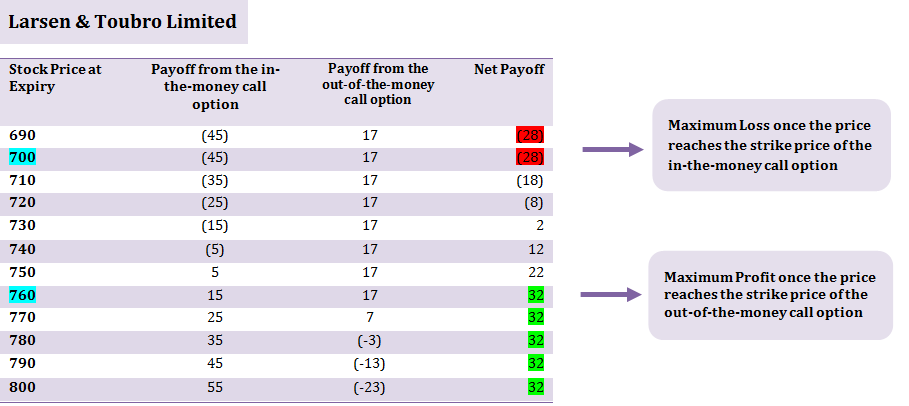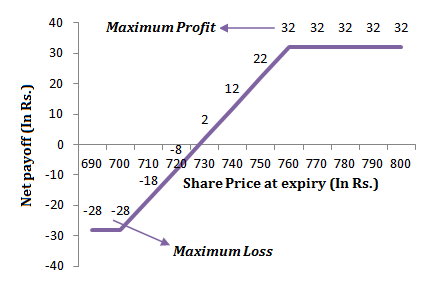When to use: Bull Call Spread Strategy is used when the investor believes that the stock will rise in future (i.e. the investor is bullish on the stock).
How it works: In a Bull Call Spread Option you buy 1 in-the-money call option and sell 1 out-of-the-money call option of the same underlying stock with the same expiry date. In this strategy, you believe that the market will be bullish until expiry. The in-the-money call will generate more and more profit as the price of the underlying stock rises. Once the price of the underlying stock reaches the strike price of the out-of-the-money call option, the profit on the call bought will start getting offset by the loss made on the call sold.
Why sell the out-of-the- money call?
The out-of-the money call option is sold only to reduce the cost (and a possible loss) on the trade. Now, if the investor was confident that the price will surely rise beyond the strike price of the out-of-the-money call option, he would be correct in not selling that call option.
For example: On 30th August 2013, Larsen & Toubro Limited share was trading at Rs. 720, you decide to buy an in-the-money call options with a strike price of Rs. 700 at a premium of Rs. 45. At the same time you sell an out-of-the-money call option with a strike price of Rs. 760 at a premium of Rs. 17.
Risk/Reward: In the Bull Call Spread Strategy, your maximum risk will be to the extent of the net premium paid (i.e. premium paid to buy the in-the-money call option – premium received on selling out-of-the-money call option). You will suffer the maximum loss if price of the underlying stock falls below the lower strike price (i.e. below the strike price of the in-the-money call option). The maximum reward/profit which you stand to make from this trade will be the difference between the two strike prices minus cost of the net premium paid.
In our example above, the investor will make the maximum profit once the price of the underlying stock reaches Rs. 760 (i.e. the strike price of the out-of-the-money call option) and will make that much profit (i.e. highest possible on this trade) so long as the price of the underlying stock remains above Rs. 760.
The table below shows the net payoff of the Bull Call Spread Strategy at different spot prices on expiry:
(click to enlarge)
The chart below allows you to easily see the break-even points, maximum profit and loss potential on expiry in rupee terms.
How to use the Bull Call Spread Option Strategy Excel calculator
Just enter your expected spot price on expiry, option strike price and the amount of premium, to estimate your net pay-off from the Bull Call Spread Option Strategy.
Note: The example and calculations are based assuming a single share though in reality options are based on lots of many shares. For example Larsen and Toubro Limited call option contract is for 375 shares. Accordingly the net premium paid will be Rs. 10,500 for 2 lots (i.e. Rs. 28.00*375) in our example.
Also Note: Unlike the buyer of an option who only pays the premium to buy the option, the seller of an option must deposit a margin amount with the exchange. This is because he takes an unlimited risk as the stock price may rise to any level. In case the price rises sharply above the strike price, the exchange utilises the margin amount to make good the profit which the option buyer makes. The amount of margin is decided by the exchange and it typically ranges from 15 % to 60 % based on the volatility in the underlying stock and market conditions. In the above example, as a seller of call option, you will have to deposit a margin of Rs. 37,135.50 (i.e. Strike price * Lot size * 13.03%) for selling/writing a lot of Larsen & Toubro Limited call option. Note that the total value of your outstanding position in this case will be Rs. 2,85,000 (i.e. strike price * lot size).




Very nice article, totally what I wanted to find.